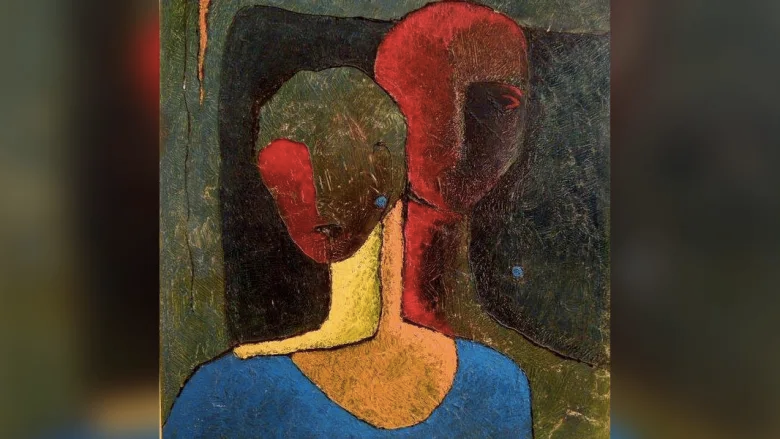The humanity of Basma Nimri
- Sophia Smith-Galer
- Jul 19, 2022
- 4 min read
This post was written by Sophia Smith-Galer (May 8 2014)
Kenworthy Hall in St Mary’s College is known mostly to students as the hectic backstage hotspot for the college’s drama performances, or as a space for the occasional Arts Society concert. However, for a short period in March, it was transformed into an emotional showcase of the art of Basma Nimri, resident at the college since January. A Jordanian artist skilled in painting, sculpting and writing, Basma owned the room on 18th March at a private viewing not only with her breathtaking works but also with her open and warm personality. At the well-attended event she welcomed any question with enthusiasm and interest, responding eloquently with her stories behind each painting.

The stories in themselves describe her eccentricity and imagination well; at a presentation one evening in the Dining Hall she was having such a good time that she ran away to paint how happy she felt – thus producing what she calls High Table Dinner.
In another more harrowing painting, of a face covered in what appears to be blood, Basma informed me how she was first trying to paint a beautiful face, but upon hearing about the violent turmoil back home in Jordan and the Levant, she was filled with such sadness and anger at the troubles that she dipped her hands in the thick red oils and scratched the surface of the painting. The result is a wounded, lonely face, staring bleakly through lines – or are they bars? – of pure red fury. The figures remain dutifully silent and sad, their pain held within but for Basma’s intuitive way with the sumptuously thick oils.
But what of the paintings themselves? The figures in them are blunt, even haunting. Their eyes are huge because Basma perceives vision as ‘greater than sight’, and they are always asymmetrical because, as she beguilingly told me, “why have two eyes but only feel one thing? You have two eyes, you feel two feelings. Each feeling is seen in your eyes.” Their noses and necks are long to represent the dignity and nobility which they hold, though here there are some contradictions; the lips are of- ten tightly pursed and small, peculiarly voiceless for an artist who has written books on womanhood and always depicts her women as naked “not because I want to show details, but because women are powerful. They have truths, they have nothing to hide.” Yet the figures remain dutifully silent and sad, their pain held within but for Basma’s intuitive way with the sumptuously thick oils.
In the one painting where the woman’s lips are open, Basma adopts such a wonderfully bruised purple that the sound of the scream is clear on the canvas. Likewise with another painting she likes to call The Box of Sorrows, a man is standing behind a woman trying to hold her, yet inside her chest we can see a box that Basma tells me holds all her pain. The woman’s gaze is detached and staring away from the man trying to console her. In each painting every feature and every gesture is painted with intention, and Basma is a deliberate artist in her portrayal of the acquiescence of and struggle with pain.
Basma lost her sister to cancer six years ago, leaving a painful imprint on the artist’s work; in the corner of Kenworthy Hall there are two paintings depicting two women, evidently Basma and her sister, and the empathy and the pain of absence and loss is made even more tragic by those long, dignified facial features that seem to evoke a resigned, poised acceptance of death.

A few paintings along, we see an image of the artist’s sister alone. Basma told me how the painting took her days, achieving the wonderful blended tone by painting millimeter by millimeter with the tip of her finger. The woman looks at peace, standing at the forefront of the painting with a dark, gridded purple background far away from her. St. Mary’s are fortunate enough to have been donated this piece by the artist herself. Basma has chosen it not only because it was painted here in Durham but because the expression on her face could as easily be that of the college’s patron saint, St. Mary.
Basma has spent only a couple of months in residence at the college, but she finished 9 works in that time. When I speak with her she marvels at the beauty of Durham’s countryside, especially the Botanic Gardens, and she tells me how her paintings have changed so much since her arrival. The colour palette is definitely different in her recent works, where bright primary colours take over from Basma’s usual blend of deep, full-bodied reds, blues and purples. I asked Basma where she in- tends on taking her art to after Durham and she tells me that she would love to have another residency in the UK and that perhaps she shall open up a small gallery with her sister in Santiago.
Wherever Basma Nimri’s paintings choose to rest, they will change the environment in which they sit; the blank square that is Kenworthy Hall in this short period of time turned into a gathering of lost souls, encouraging the viewer to question their hidden stories with the jarring colours and heavy oils bringing about an overwhelming catharsis. Basma said to the guests that you can be skillful, but not powerful, and in her works it is clear that she knows the exact formula to be both.
Photographs were taken by Sophia Smith-Galer



Comments